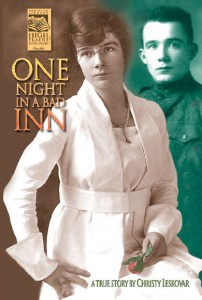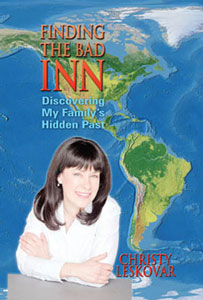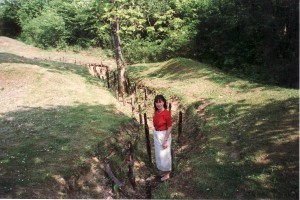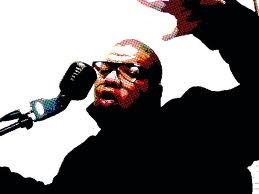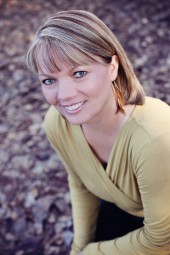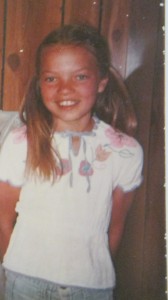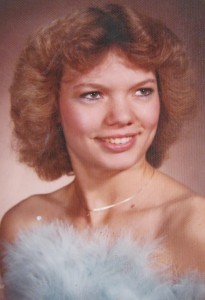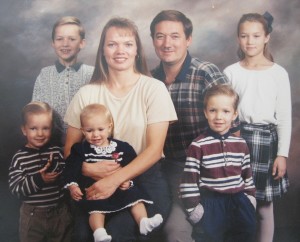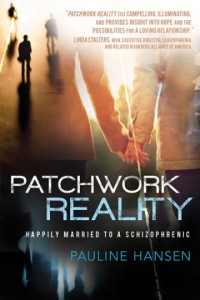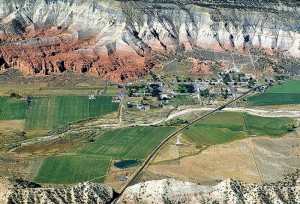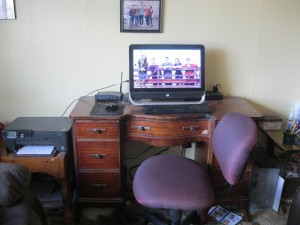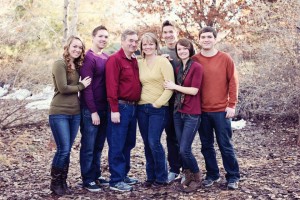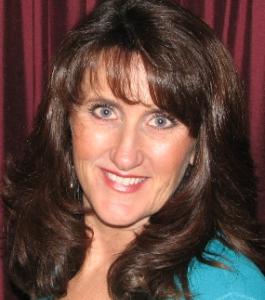Christy Leskovar had a solid career in mechanical engineering when she happened upon some family history that was too intriguing to ignore. As she delved into the truths behind the tale, she knew this was a story waiting to be written and, setting aside her career, she set off to do just that. What resulted was her first published work–ONE NIGHT IN A BAD INN–a true story of “scandal, war, murder, and mayhem.”
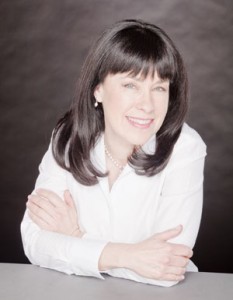 ME: You were born in Butte, Montana but grew up in Kennewick, Washington. Do you have any childhood memories of Butte, and, if so, which ones stand out the most? Also, how does the Kennewick of your childhood differ from what it is today? (I’d love to post pictures of you as a child in Montana and in Kennewick.)
ME: You were born in Butte, Montana but grew up in Kennewick, Washington. Do you have any childhood memories of Butte, and, if so, which ones stand out the most? Also, how does the Kennewick of your childhood differ from what it is today? (I’d love to post pictures of you as a child in Montana and in Kennewick.)
CHRISTY: Memories of childhood in Butte – playing piano by ear at Grandma T’s while she and Mom visited in the front room; the house shaking at 4 pm when they blasted in the mine; Dad pulling my brother and me on the sled when we went out to the forest to chop down a tree for Christmas; getting a ride home from school in the cab of the next door neighbor’s cement truck; the nuns’ formidable long black habits at St. Ann’s (I’ll bet you have some good nun stories…:D); playing kick the can in the alley; the 9 pm curfew siren; snow so high we could barely see the mailbox.
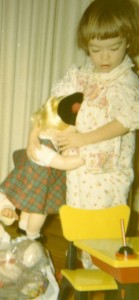 (Christy gets a writing desk for Christmas in Butte…signs of things to come)
(Christy gets a writing desk for Christmas in Butte…signs of things to come)
As for the Kennewick of my childhood differing from today, the Tri-Cities have grown so much since we moved there at the end of 1968. That’s the biggest difference. There are many more wineries too. (Amen!)
ME: Before you discovered the long-hidden truth about your great-grandmother that led to your writing ONE NIGHT IN A BAD INN, what were some of the most interesting things you had heard about her? (And is there a picture of her with your great-grandfather that you can share?)
CHRISTY: Before hearing that she was arrested for murdering her husband, the most startling thing I had heard about her was that she tried to force her daughter (my grandmother) into prostitution. Grandma T told me that.
(Wow! That was some kind of mother.)
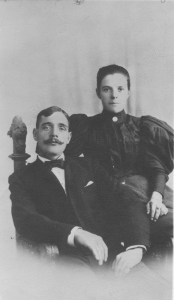 (Sarah with Arthur Hughes before she allegedly killed him…see those cold, hard eyes?)
(Sarah with Arthur Hughes before she allegedly killed him…see those cold, hard eyes?)
ME: Okay, I can kind of tell from your college degrees in both Mechanical Engineering and French that you were somewhat undecided between the Humanities and Math and Sciences. So I wasn’t completely surprised that, after a solid career as an engineer, you decided to put it aside and try your hand at writing. Still, to do something like that, you must have had some early success with the written word. When and how did you know you had it in you to write a book?
CHRISTY: I didn’t think about it in those terms. I just did it.
(That has to be a record on my blog for the shortest answer to the longest question ever!)
ME: Some writers seem to have it in them from an early age and stories tumble out of them. Others come to it later in life, particularly when one story, in particular, captures their imagination. Tell us how ONE NIGHT IN A BAD INN came to you and why you were so sure you had to tell this story.
CHRISTY: I had gone to Butte for a family funeral. While visiting Aunt Aila, she pulled out a box and from it some papers which she passed to us. They were rap sheets from the prison – for my great-uncles Bill and Archie, Grandma T’s brothers. I barely knew she had brothers (no surprise after seeing the rap sheets). Then Auntie Mary told us about the fire on the ranch, and finding the body, and that Great-grandma Sarah was arrested for murdering Arthur. I went home, went back to work at Bechtel, and then one afternoon the idea just popped in my head: I was going to go find out what happened and write a book about it.
ME: Doing the research for this particular family saga required a lot of travel. Please describe some of the surprising places and events you found you had to investigate to do this story justice. (And I’d love a picture or two from your travels.)
CHRISTY: It was an unforgettable adventure, chronicled in my second book, FINDING THE BAD INN. One of the biggest surprises was finding out that one of the prisoners escaped. What an escapade that turned out to be.
As for my travels, I went everywhere anything significant happened, which included Montana, New York, Pennsylvania, Oregon, Wales, Northern Ireland, France, and Belgium. I was attacked by a dog on a Welsh farm, had a policeman train his automatic weapon on me in Belfast, and was hospitalized in Belgium. (Can you tell how dedicated she was to uncovering the whole saga?)
Along the way I gathered amazing story after amazing story. One of the most exciting physical finds was discovering the old stone house where Sarah lived in Wales.
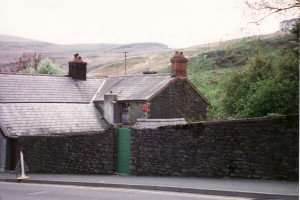 (Sarah’s old stone house in Wales)
(Sarah’s old stone house in Wales)
(And here’s her book trailer for her second book)
ME: What or who helped you decide to create a second book out of what was essentially your journey of research for the first?
CHRISTY: After my trip to Wales, Ireland, France, and Belgium, I felt like I was living in a novel. Finding the story became as interesting as the story I was finding. I decided to write down what happened–my search for the story–just to preserve it for myself. Then I realized, there’s a book here.
In light of what has come out about several memoirs, I’m glad I did it, though ONE NIGHT IN A BAD INN isn’t a traditional memoir in that it was assiduously researched.
ME: Do you have more stories in the pot stemming from your own family history and, if so, what may we expect to see next from you? I know, for example, that after the murder of her father, your grandmother was sent off to an orphanage. Did you cover her story enough in your first book or can you see possibly devoting a third book to your grandmother’s life story? (And I’d love to post a picture of you with your grandmother.)
CHRISTY: The story of Sarah’s being arrested for killing her husband is just Part One of ONE NIGHT IN A BAD INN, which has six parts. After the mystery of the fire on the ranch is solved, at least in part, the story continues with my grandmother getting out of the orphanage, moving to the raucous mining town of Butte, Montana, (this was in 1915), meeting her handsome, footloose future husband who goes off to the First World War. It’s quite a story. (It certainly sounds like it!)
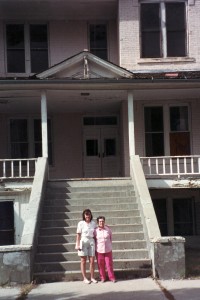 (Christy with her grandmother in front of the old orphanage)
(Christy with her grandmother in front of the old orphanage)
(Christy in a World War I trench during research)
Originally, I planned to write a book about all four grandparents, but as I got into the research, the story grew by leaps and bounds. There was more than enough story about my maternal grandparents for one book. My paternal grandparents are the protagonists of my next book, which I’m researching now. As with ONE NIGHT IN A BAD INN, it will be nonfiction, researched, and put in historical context.
(We’ll have to keep an eye out for it.)
ME: What are some of the most important things to remember when writing memoir, or true crime, or family history?
CHRISTY: Get the facts, and the memories, in context. Corroborate everything you can. You find more story that way, and you get closer to the truth. Even things you read in well-regarded “history books,” if something doesn’t sound right, research it.
ME: How did you personally keep all of your research materials organized so you could quickly find and refer to them as you were writing?
CHRISTY: I kept notes in notebooks and transcribed them onto the computer. I kept a timeline and notes by subject. I reviewed them many, many times. I wrote from memory, then went back to my notes and timeline to fact check myself.
(As you can tell, writing history accurately requires a great deal of patience and persistence.)
ME: Finally, could you describe your personal writing space in the voice of your great-grandmother. (And I’d love to post a picture of your office or writing area.)
CHRISTY: In the voice of my great-grandmother, my goodness! She was a cross between Auntie Mame and Fagin (What a combination!), so I’ll leave that up to the imagination of the reader. As for my writing space, I have a desk with a bookcase and file drawers in front of window with a lovely view, palm trees in the distance.
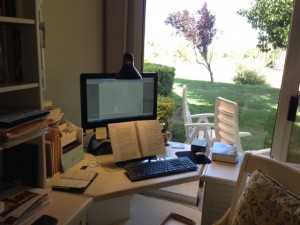 (Hmmm…now how would Auntie Mame and Fagin describe this?)
(Hmmm…now how would Auntie Mame and Fagin describe this?)
Seriously, readers, if you want to give it a try, please post your best efforts in the Comments section. :D I’ll let Christy be the judge as to who captures her villainous, adventurous great-grandmother the best.
In the meantime, you can learn more about Christy and her writing on her website. And you can buy her book on Amazon.
Note: I apologize for not posting my promised interview with Karen Spears Zacharias last week, but a family situation came up that I had to attend to. I’ll try and catch her again in a couple of months.
Meanwhile, check back here next Wednesday for my interview with the popular and entertaining poet Jordan Chaney.
Originally posted 2013-09-25 06:00:58.

